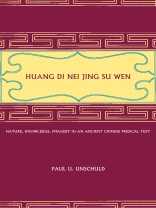The
Huang Di nei jing su wen, known familiarly as the
Su wen, is a seminal text of ancient Chinese medicine, yet until now there has been no comprehensive, detailed analysis of its development and contents. At last Paul U. Unschuld offers entry into this still-vital artifact of China’s cultural and intellectual past.
Unschuld traces the history of the
Su wen to its origins in the final centuries B.C.E., when numerous authors wrote short medical essays to explain the foundations of human health and illness on the basis of the newly developed vessel theory. He examines the meaning of the title and the way the work has been received throughout Chinese medical history, both before and after the eleventh century when the text as it is known today emerged. Unschuld’s survey of the contents includes illuminating discussions of the yin-yang and five-agents doctrines, the perception of the human body and its organs, qi and blood, pathogenic agents, concepts of disease and diagnosis, and a variety of therapies, including the new technique of acupuncture. An extensive appendix, furthermore, offers a detailed introduction to the complicated climatological theories of
Wu yun liu qi (‘five periods and six qi’), which were added to the
Su wen by Wang Bing in the Tang era.
In an epilogue, Unschuld writes about the break with tradition and innovative style of thought represented by the
Su wen. For the first time, health care took the form of ‘medicine, ‘ in that it focused on environmental conditions, climatic agents, and behavior as causal in the emergence of disease and on the importance of natural laws in explaining illness. Unschuld points out that much of what we surmise about the human organism is simply a projection, reflecting dominant values and social goals, and he constructs a hypothesis to explain the formation and acceptance of basic notions of health and disease in a given society. Reading the
Su wen, he says, not only offers a better understanding of the roots of Chinese medicine as an integrated aspect of Chinese civilization; it also provides a much needed starting point for discussions of the differences and parallels between European and Chinese ways of dealing with illness and the risk of early death.
Tabela de Conteúdo
Prefatory Remarks
I. Bibliographic History of the Su wen
1. Some Scholarly Views on the Origin of the Su wen
2. References to Huang Di nei jing and Su wen in Early Bibliographic Sources
II. The Meaning of the Title Huang Di Nei Jing Su wen
1. Huang Di
2. Nei
3. Jing
4. Su wen
III. Early Su wen texts and commentaries before the eleventh century
1. Huangfu Mi and the Jia yi jing
2. Quan Yuanqi and the Su wen xun jie
3. Yang Shangshan and the Huang Di nei jing tai su
3.1. History and Reconstruction of a Tai su Text in Japan
3.2. The Issue of the Chinese Master Copies of the Tai su
3.3. Yang Shangshan’s Commentaries
4. Wang Bing’s Su wen Edition of a.d.
4.1. Wang Bing, His Intentions and His Preface
4.2. Structural Characteristics of the Wang Bing Edition
4.3. Discourses 66 through 74 in Today’s Su wen
4.4. The Influence of Wang Bing’s Worldview on His Su wen Edition
4.5. Scope and Structure of Wang Bing’s Commentaries
IV. Origin and tradition of the textus receptus of the Su wen
1. The Imperial Editorial Office of 1057
2. The Scope of the Revision by Gao Baoheng et al.
3. The Major Commentated Su wen Versions Subsequent to Gao Baoheng et al.
3.1. Ma Shi’s Huang Di nei jing su wen zhu zheng fa wei
3.2. Wu Kun’s Huang Di nei jing su wen zhu
3.3. Zhang Jiebin’s Lei jing
3.4. Zhang Zhicong’s Huang Di nei jing su wen ji zhu
3.5. Gao Shishi’s Huang Di su wen zhi jie
3.6. Zhang Qi’s Su wen shi yi
3.7. Hu Shu’s Huang Di nei jing su wen jiao yi
3.8. Yu Yue’s Nei jing bian yan
4. Two Japanese Commentated Su wen Versions of the Edo Period
4.1. Tamba Genkan’s Su wen shi
4.2. Tamba Genken’s Su wen shao shi
V. A survey of the contents of the Su wen
1. The Literary Setting
2. The Yin-Yang Doctrine
2.1. The Discovery of Dualism
2.2. The Fourfold Subcategorization
2.3. The Sixfold Subcategorization
2.4. An Eightfold or Tenfold Subcategorization?
2.5. Yin-Yang Physiology, Pathology, and Diagnosis
3. The Five-Agents Doctrine
3.1. General Remarks
3.2. Early References to Pentic Categorizations
3.3. Early Notions of Correspondences among Phenomena
3.4. Early Patterns of Correspondences
3.5. The Status Quo of the Five-Agents Doctrine in the Su wen
3.6. The Significance of the Five-Agents Doctrine in the Su wen
4. The Body and Its Organs
4.1. Su wen Morphology
4.2. Chest and Abdomen
4.3. The Head
4.4. The Extremities
4.5. General Structural Elements and Mobile Agents
4.6. Toward a Hierarchy of Human Organs
4.7. Depots, Palaces, Containers, and Officers
4.8. Links between Organs and Orifices
4.9. The Organism as a System of Morphological Entities and Their Functions
5. Blood and Qi
5.1. Blood
5.2. Qi
5.3. Camp Qi and Protective Qi
6. The Vessels
6.1. Vessel Theory in the Mawangdui Manuscripts
6.2. Vessel Morphology in the Su wen
6.3. Vessel Pathology
6.4. The Contents of the Vessels
6.5. Vessel Flow
7. Pathogenic Agents
7.1. From Bugs and Demons to Natural Environmental Factors
7.2. Wind Etiology and Pathology
7.3. Wind Etiology and Leprosy
7.4. Wind Etiology and Malaria
7.5. Dampness, Cold, Heat, and Dryness
8. Diseases
8.1. Lifestyle and Prevention
8.2. Ontological and Functional Views
8.3. Disease Terminology
8.4. Malaria
8.5. Cough
8.6. Lower Back Pain
8.7. Limpness
8.8. Block
8.9. Recession
8.10. Somatopsychic Diseases
8.11. Beyond Conceptualization
9. Examination
9.1. General Principles
9.2. Inspection
9.3. Inquiries
9.4. Three Sections and Nine Indicators
9.5. Empirical and Conceptualized Prognosis
9.6. Vessel Diagnosis of Disease
9.7. Conclusion
10. Invasive Therapies
10.1. The Concept of Invasive Intervention
10.2. Bloodletting
10.3. Bloodletting to Treat Qi
10.4. Misleading Piercing and Grand Piercing
10.5. Genuine Qi Manipulation
10.6. Morphological Piercing
10.7. The Technique of Piercing
11. Substance Therapies
11.1. From Materia Medica to Pharmacology
11.2. Pharmacotherapy in the Main Text of the Su wen
11.3. Drug Qualities and Dietary Therapy
11.4. The Dawn of Pharmacology in the “Seven Comprehensive Discourses”
12. Heat Therapies
12.1. Conceptual Levels prior to Vessel Theory
12.2. Cauterization and Vessel Theory
VI. Epilogue: toward a comparative historical anthropology of medical thought
1. The Su wen: Document of a New Style of Thought
2. Social Facts, Worldviews, and Medical Ideas: Parallel Structures
3. Philosophical Key Terms in a Medical Context
4. Conclusion
Notes
Appendix
The doctrine of the five periods and six qi in the huang di nei jing su wen
Bibliography
Index
Sobre o autor
Paul U. Unschuld is Professor and Director of the Institute for the History of Medicine at Munich University. His books previously published by California include Medicine in China: A History of Pharmaceutics (1986), Nan-ching—The Classic of Difficult Issues (1986), Medicine in China: A History of Ideas (1988), and Essential Subtleties on the Silver Sea (with Jürgen Kovacs, 1998).












